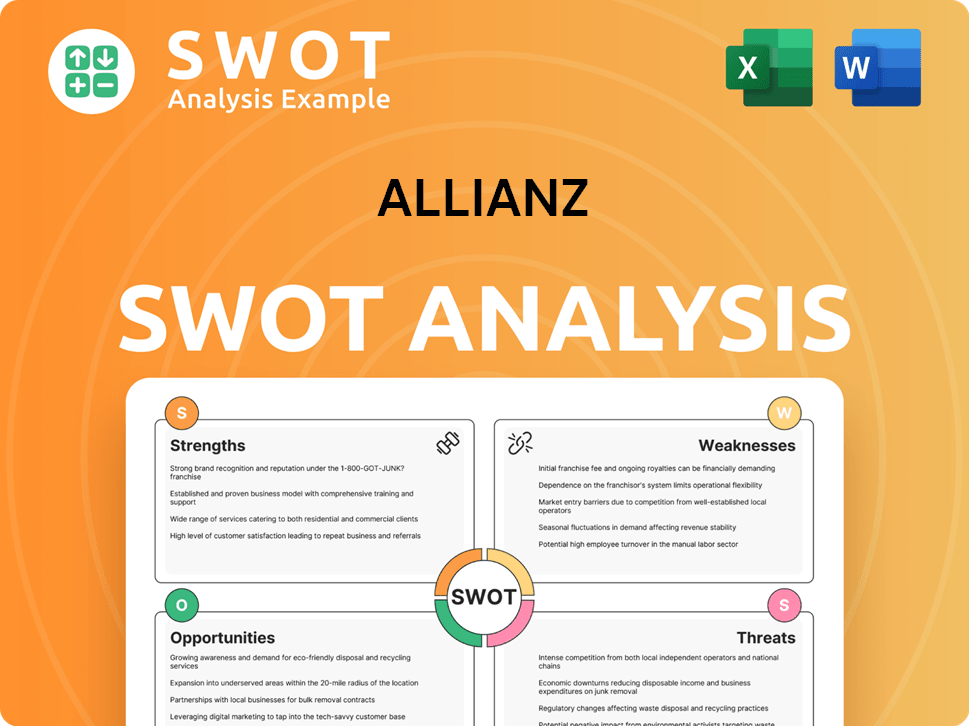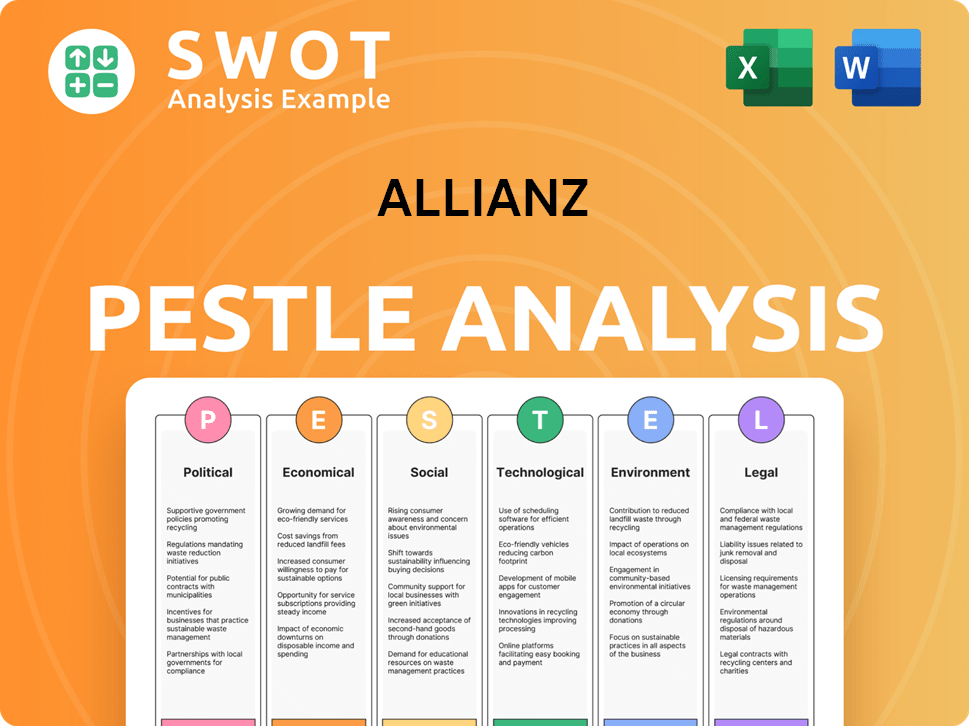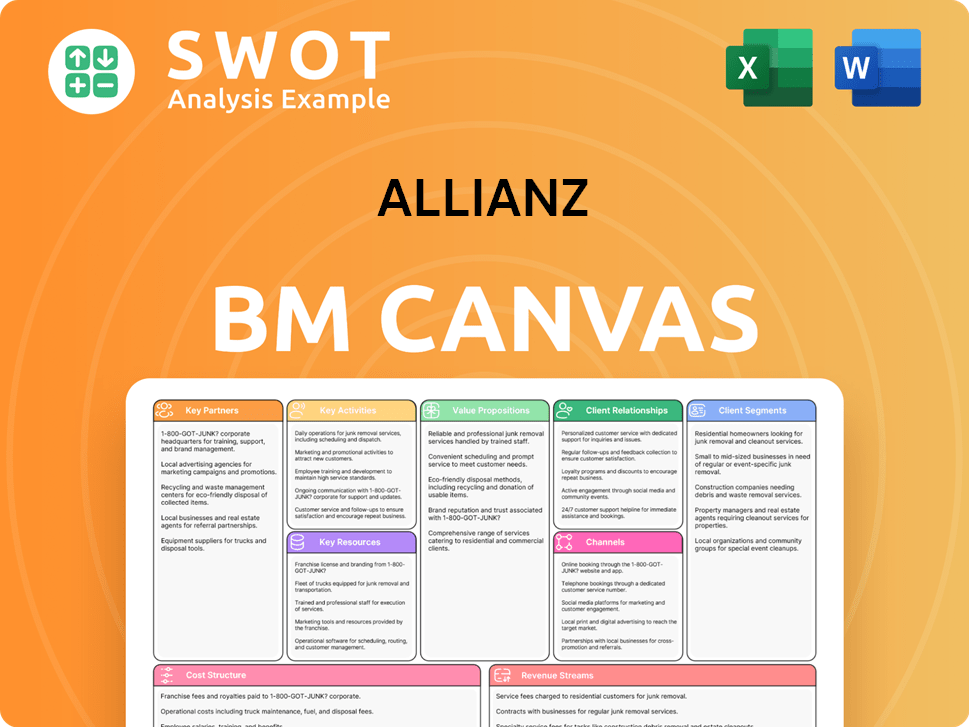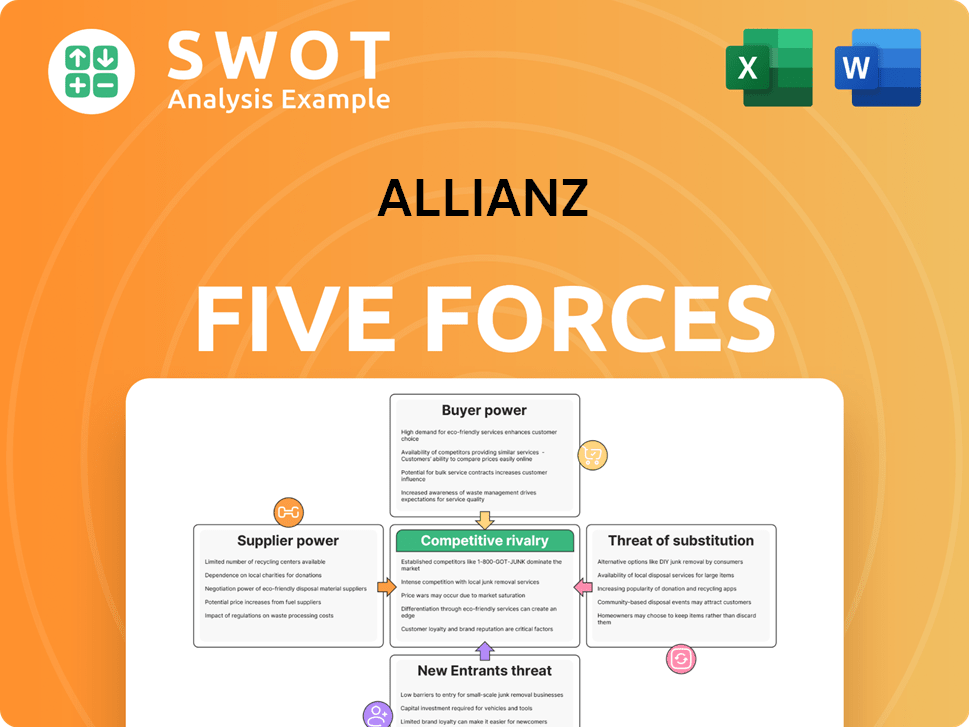Allianz Bundle
Can Allianz Maintain Its Growth Trajectory?
Allianz SE, a titan in the financial services sector, is constantly evolving, with its Allianz SWOT Analysis revealing key strategies for navigating the complex insurance and asset management landscapes. A recent strategic move, the acquisition of a majority stake in Singapore's Income Insurance, highlights Allianz's proactive approach to expansion. This bold step is set to reshape its market position in the burgeoning Asia-Pacific region.

This analysis delves into the Allianz growth strategy, examining its recent financial performance and future prospects. We will explore how Allianz plans to expand its business, focusing on its investment strategy and digital transformation initiatives. Understanding Allianz's competitive advantages and its response to insurance industry trends is crucial for investors and strategists alike, especially in light of the challenges facing Allianz company in a dynamic global market.
How Is Allianz Expanding Its Reach?
The expansion initiatives of the company are a key component of its overall growth strategy. These initiatives involve strategic acquisitions and enhancements to product and service offerings. This approach is designed to boost market share and enhance its position within the insurance industry.
A significant move in this direction is the proposed acquisition of a majority stake in Singapore's Income Insurance. This strategic move is expected to solidify its presence in the Asian insurance market. The company's growth strategy also includes organic growth, such as the development of advanced protection and retirement solutions.
The company's financial performance in 2023, with nearly €7.7 billion in total business volume across its P&C and L&H businesses, demonstrates its strong foundation for further expansion. The company's focus on both inorganic and organic growth strategies is a key element for its future prospects.
In July 2024, the company announced the proposed acquisition of a majority stake in Singapore's Income Insurance. This €1.5 billion transaction is expected to close in late 2024 or early 2025. This acquisition aims to establish a leading position in the Asian insurance market, particularly in Singapore.
In March 2025, the company completed the acquisition of Viridium Gruppe, a life insurance company. This acquisition cost $3.82 billion, further demonstrating its inorganic growth strategy. This acquisition is part of a broader strategy to expand its market presence and service offerings.
The company's strategy through 2027 focuses on acquiring new customers and boosting retention. This includes offering advanced protection and retirement solutions. The company is also targeting specific financial goals for its various business segments.
The property-casualty segment anticipates annual revenue growth of 6–7% and an operating profit of around €9.5 billion by 2027. For life and health insurance, the company anticipates an operating profit of approximately €6 billion by 2027, with a new business margin of at least 5%. These targets reflect the company's long-term financial goals and its commitment to sustained growth.
The company's expansion initiatives are central to its Allianz growth strategy, targeting both organic and inorganic growth. The acquisition of Income Insurance and Viridium Gruppe are prime examples of its strategic acquisitions. These moves are expected to enhance the company's market share and financial performance.
- The acquisition of Income Insurance is a key step towards dominating the Asian market.
- The Viridium Gruppe acquisition strengthens its life insurance portfolio.
- Financial targets include significant revenue growth and profitability targets.
- The company's focus on customer acquisition and retention is a core element of its strategy.
Allianz SWOT Analysis
- Complete SWOT Breakdown
- Fully Customizable
- Editable in Excel & Word
- Professional Formatting
- Investor-Ready Format

How Does Allianz Invest in Innovation?
The company's approach to innovation is central to its long-term Allianz growth strategy, with a strong emphasis on digital transformation. This focus is designed to meet the evolving needs of the insurance market. The strategic agenda for 2024-2027 underscores the importance of productivity enhancements through efficiency initiatives and the integration of generative AI.
This commitment to innovation is also evident in its sustainability efforts. The company is actively integrating sustainability into its business practices and investment strategies. In March 2025, the company published its first Corporate Sustainability Reporting Directive (CSRD)-compliant Annual Report, highlighting its progress in climate strategy and commitment to transparency.
The company's dedication to sustainability is further demonstrated through its investments and customer initiatives. Their sustainable investing and stewardship report for 2024 highlights achievements in building out their sustainability strategy, including managing 64% of their mutual fund AUM according to a sustainable investing approach. This approach shows how the company is adapting to Allianz future prospects in the insurance industry.
The company is focused on digital transformation to improve efficiency and customer experience. This involves the adoption of new technologies and the streamlining of processes. The goal is to enhance productivity and meet the changing demands of the market.
The strategic integration of generative AI is a key aspect of the company's innovation strategy. This technology is being used to improve various aspects of the business. This includes customer service and operational efficiency.
The company is committed to sustainability, reflected in its investments and reporting. The company is increasing sustainable investments and revenues. It is also accelerating customer transitions to sustainable practices.
The company manages a significant portion of its assets under management (AUM) according to a sustainable investing approach. This demonstrates a commitment to environmental, social, and governance (ESG) factors. This is a core part of its long-term strategy.
The company is committed to transparency, as evidenced by its CSRD-compliant reporting. This reporting highlights progress in climate strategy and other sustainability initiatives. This helps to build trust with stakeholders.
The company actively engages with businesses on emerging technologies. This includes artificial intelligence. This proactive stance ensures that the company stays at the forefront of technological advancements.
The company's innovation strategy involves several key technologies and strategic initiatives. These efforts are designed to drive Allianz company analysis and growth. This includes a focus on digital capabilities and sustainability.
- Digitalization of core processes to improve efficiency.
- Integration of AI and machine learning for enhanced customer service.
- Expansion of sustainable investment options and practices.
- Strategic partnerships to leverage external innovation.
Allianz PESTLE Analysis
- Covers All 6 PESTLE Categories
- No Research Needed – Save Hours of Work
- Built by Experts, Trusted by Consultants
- Instant Download, Ready to Use
- 100% Editable, Fully Customizable

What Is Allianz’s Growth Forecast?
The financial outlook for Allianz is robust, with the company setting ambitious targets for the 2024-2027 period. This reflects a strong belief in its future growth potential within the insurance industry. The company's strategic focus and operational efficiency are designed to capitalize on emerging insurance industry trends and expand its market share.
Allianz's strategic plans include a focus on achieving sustainable and profitable growth. This involves a combination of organic expansion, strategic partnerships, and digital transformation initiatives. The company's commitment to financial strength is evident in its Solvency II ratio and its focus on delivering value to shareholders.
Allianz aims for an earnings per share (EPS) compound annual growth rate (CAGR) of between 7% and 9%. Additionally, it is targeting a return on equity of at least 17%. From 2025 to 2027, Allianz plans to remit over €27 billion in net cash. These goals demonstrate the company's commitment to enhancing shareholder value. For more insights into the company's core values, check out the Mission, Vision & Core Values of Allianz.
In Q1 2025, Allianz reported a record operating profit of €4.2 billion, marking a 6.3% increase year-over-year. This positive performance is a key indicator of Allianz's financial health and its ability to meet its full-year operating profit target of €16 billion. Total business volume group-wide rose by 11.7% to €54 billion in Q1 2025.
The Property & Casualty segment achieved its highest quarterly operating profit ever at €2.2 billion in Q1 2025, with a combined ratio improving to 91.8%. The Life & Health segment's operating profit increased to €1.4 billion, up 7.5% year-over-year, and the present value of new business premiums grew by 16.8% to €26.1 billion. The Asset Management segment's operating profit increased by 4.8% to €811 million.
Despite a slight miss in forecasted EPS (€6.61 actual vs. €6.74 forecast), Allianz's revenue significantly surpassed expectations, reaching €54 billion compared to a forecasted €18.65 billion. This indicates strong revenue growth drivers and effective customer acquisition strategies. The company's strong revenue performance helps in its competitive advantages.
Allianz maintains a solid Solvency II ratio of 208% as of Q1 2025, demonstrating its financial strength. This strong capital position supports its ability to invest in future growth and navigate any challenges facing the company. The company's financial stability is crucial for its long-term financial goals.
For 2024, Allianz reported a record operating profit of €16.0 billion, an 8.7% increase from the previous year. Total business volume rose 11.2% to €179.8 billion. Shareholders' core net income for 2024 increased by 10.1% to €10.0 billion.
Allianz's strategic focus includes expanding into new markets and leveraging digital transformation. The company is investing in sustainability initiatives to align with global trends. These strategies are designed to drive long-term value and enhance its impact on the global economy.
Allianz's strong financial performance and strategic initiatives support its leading position in the insurance market. The company's ability to adapt to insurance industry trends and its focus on customer acquisition strategies are key to maintaining its market share. Allianz's strategic partnerships also contribute to its market position.
Allianz's future prospects are promising, supported by its strong financial performance and strategic plans. The company's commitment to innovation and its focus on sustainable growth position it well for continued success. Allianz's investment strategy is designed to deliver long-term value.
While Allianz faces challenges, including regulatory changes and economic uncertainties, its strong financial foundation and strategic initiatives help it navigate these issues. The company's risk management practices and its focus on operational efficiency are essential for mitigating potential risks. Allianz's digital transformation strategy is also crucial.
Allianz's growth strategy includes expansion into new markets, particularly in the Asia Pacific region, and leveraging digital technologies. The company's focus on customer acquisition and its commitment to sustainability are key drivers of its long-term financial goals. These strategies are designed to enhance Allianz's competitive advantages.
Allianz Business Model Canvas
- Complete 9-Block Business Model Canvas
- Effortlessly Communicate Your Business Strategy
- Investor-Ready BMC Format
- 100% Editable and Customizable
- Clear and Structured Layout

What Risks Could Slow Allianz’s Growth?
The Allianz growth strategy faces significant risks that could hinder its progress. These challenges span operational, financial, and geopolitical areas, demanding robust risk management and strategic agility. Understanding these potential obstacles is crucial for evaluating the Allianz company analysis and its future prospects.
One major concern is the rising frequency and impact of cyber incidents. Furthermore, business interruption, often linked to cyberattacks or natural disasters, poses a substantial threat. The increasing severity of natural catastrophes, coupled with regulatory changes, adds to the complex risk landscape.
Geopolitical risks and violence, along with the emergence of new technologies like AI, are also noteworthy. Rising global business insolvencies further compound the challenges, potentially impacting the financial sector.
Cyber incidents remain the top global business risk for the fourth consecutive year, according to the Allianz Risk Barometer 2025. Data breaches and ransomware attacks are primary concerns for the Allianz growth strategy. These incidents can lead to significant financial losses and reputational damage.
Business interruption is the second highest concern, often stemming from cyberattacks, natural disasters, or geopolitical events. Supply chain disruptions, as seen in 2024 due to incidents like the Houthi attacks in the Red Sea and the collapse of the Francis Scott Key Bridge, can severely impact operations. These disruptions can affect Allianz market share.
Natural catastrophes rank third, reflecting the increasing impact of extreme weather events. Insured losses exceeded USD 100 billion for the fifth consecutive year in 2024, highlighting the financial exposure. This trend presents a challenge for Allianz future prospects.
Regulatory changes, particularly in sustainability and technology, pose significant challenges, ranking fourth. Evolving requirements and emerging technological standards demand continuous adaptation. Compliance costs and potential penalties can affect the financial performance Allianz.
Geopolitical risks and violence, ranking ninth, include civil unrest and supply chain impacts. Tensions like the conflicts in Ukraine and the Middle East, as well as those between the US and China, contribute to supply chain disruptions. These factors can increase the potential for shareholder lawsuits and penalties, affecting Owners & Shareholders of Allianz.
Rising global business insolvencies, projected to increase by 11% in 2024 and a further 2% in 2025, pose a threat. Sectors like construction, retail, and services are particularly vulnerable, potentially putting over 1.6 million jobs at risk in Europe and North America by 2025. This impacts the overall insurance industry trends.
Allianz addresses these risks through diversification, robust risk management frameworks, and continuous monitoring. The company’s ability to adapt to the changing risk landscape is crucial for its long-term success. This includes proactive measures to counter cybersecurity threats and business interruptions, and strategic partnerships.
The entry of new technologies, including AI, into the top 10 risks highlights the need for innovation and adaptation. Allianz must navigate the opportunities and challenges presented by new technologies. This includes investment in digital transformation and AI-driven solutions to enhance its operations and customer service capabilities.
Allianz Porter's Five Forces Analysis
- Covers All 5 Competitive Forces in Detail
- Structured for Consultants, Students, and Founders
- 100% Editable in Microsoft Word & Excel
- Instant Digital Download – Use Immediately
- Compatible with Mac & PC – Fully Unlocked

Related Blogs
- What are Mission Vision & Core Values of Allianz Company?
- What is Competitive Landscape of Allianz Company?
- How Does Allianz Company Work?
- What is Sales and Marketing Strategy of Allianz Company?
- What is Brief History of Allianz Company?
- Who Owns Allianz Company?
- What is Customer Demographics and Target Market of Allianz Company?
Disclaimer
All information, articles, and product details provided on this website are for general informational and educational purposes only. We do not claim any ownership over, nor do we intend to infringe upon, any trademarks, copyrights, logos, brand names, or other intellectual property mentioned or depicted on this site. Such intellectual property remains the property of its respective owners, and any references here are made solely for identification or informational purposes, without implying any affiliation, endorsement, or partnership.
We make no representations or warranties, express or implied, regarding the accuracy, completeness, or suitability of any content or products presented. Nothing on this website should be construed as legal, tax, investment, financial, medical, or other professional advice. In addition, no part of this site—including articles or product references—constitutes a solicitation, recommendation, endorsement, advertisement, or offer to buy or sell any securities, franchises, or other financial instruments, particularly in jurisdictions where such activity would be unlawful.
All content is of a general nature and may not address the specific circumstances of any individual or entity. It is not a substitute for professional advice or services. Any actions you take based on the information provided here are strictly at your own risk. You accept full responsibility for any decisions or outcomes arising from your use of this website and agree to release us from any liability in connection with your use of, or reliance upon, the content or products found herein.